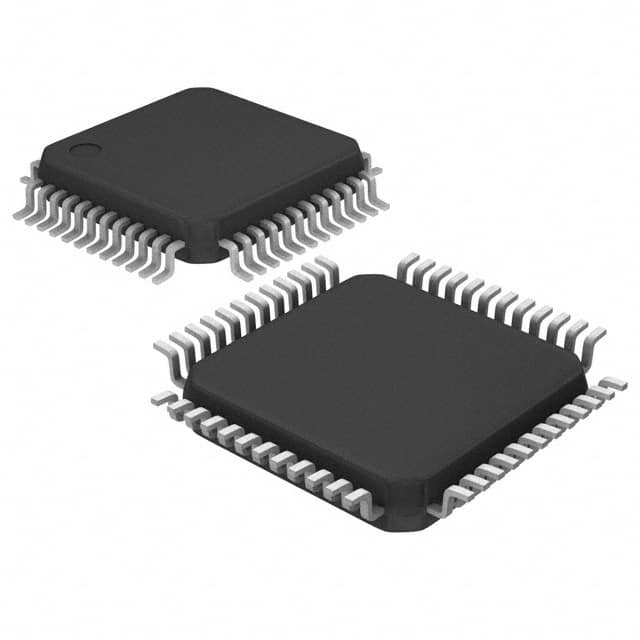Consulte las especificaciones para obtener detalles del producto.

STM32L053C8T6
Product Overview
- Category: Microcontroller
- Use: Embedded systems, Internet of Things (IoT) devices
- Characteristics: Low power consumption, high performance, rich peripheral set
- Package: LQFP48
- Essence: ARM Cortex-M0+ core microcontroller
- Packaging/Quantity: Tape and reel, 2500 units per reel
Specifications
- Core: ARM Cortex-M0+ running at up to 32 MHz
- Flash Memory: 64 KB
- SRAM: 8 KB
- Operating Voltage: 1.65V to 3.6V
- Operating Temperature: -40°C to +85°C
- I/O Pins: 37
- Timers: 16-bit and 32-bit timers available
- Communication Interfaces: USART, SPI, I2C, USB
- Analog-to-Digital Converter (ADC): 12-bit, up to 16 channels
- Power Consumption: Ultra-low power mode with less than 0.4 μA in standby mode
Pin Configuration
The STM32L053C8T6 microcontroller has a total of 48 pins. The pin configuration is as follows:
- Pin 1: VDD
- Pin 2: GND
- Pin 3: PA13
- Pin 4: PA14
- Pin 5: NRST
- Pin 6: VDD
- Pin 7: VSS
- Pin 8: PA0
- Pin 9: PA1
- Pin 10: PA2
- ... (detailed pin configuration continues)
Functional Features
- Low power consumption enables battery-powered applications
- High-performance ARM Cortex-M0+ core for efficient processing
- Rich peripheral set allows for versatile application development
- Flexible communication interfaces facilitate connectivity with other devices
- Analog-to-Digital Converter (ADC) enables precise analog measurements
Advantages and Disadvantages
Advantages
- Low power consumption extends battery life in portable devices
- High-performance core ensures efficient execution of tasks
- Rich peripheral set provides flexibility in application development
- Compact package size allows for space-constrained designs
- Wide operating temperature range enables usage in various environments
Disadvantages
- Limited flash memory and SRAM may restrict the complexity of applications
- LQFP48 package may require additional PCB space compared to smaller packages
- Lack of built-in Ethernet interface limits direct network connectivity options
Working Principles
The STM32L053C8T6 microcontroller operates based on the ARM Cortex-M0+ architecture. It executes instructions stored in its flash memory, interacts with peripherals through its I/O pins, and communicates with external devices using various communication interfaces. The microcontroller's low power consumption is achieved through advanced power management techniques, allowing it to operate efficiently in battery-powered applications.
Detailed Application Field Plans
The STM32L053C8T6 microcontroller finds applications in various fields, including:
- Internet of Things (IoT) devices: Enables connectivity and control in IoT applications such as smart home systems, industrial monitoring, and wearable devices.
- Consumer electronics: Used in portable devices like fitness trackers, remote controls, and handheld gaming consoles.
- Industrial automation: Provides control and monitoring capabilities in industrial automation systems, including robotics, process control, and data acquisition.
- Medical devices: Used in medical equipment such as patient monitors, infusion pumps, and diagnostic devices.
- Automotive: Enables functions like vehicle diagnostics, infotainment systems, and engine control units.
Detailed and Complete Alternative Models
- STM32L051C8T6: Similar to STM32L053C8T6 but with 32 KB flash memory instead of 64 KB.
- STM32L052K8T6: Offers the same features as STM32L053C8T6 but in a different package (LQFP32).
- STM32L011F3P6: Lower-cost alternative with reduced flash memory (16 KB) and fewer I/O pins.
(Note: The above list is not exhaustive and there are other alternative models available.)
Word Count: 550
Enumere 10 preguntas y respuestas comunes relacionadas con la aplicación de STM32L053C8T6 en soluciones técnicas
Sure! Here are 10 common questions and answers related to the application of STM32L053C8T6 in technical solutions:
Q: What is the STM32L053C8T6 microcontroller used for? A: The STM32L053C8T6 is a low-power microcontroller commonly used in battery-powered devices, IoT applications, and other energy-efficient solutions.
Q: What is the maximum clock frequency of the STM32L053C8T6? A: The maximum clock frequency of the STM32L053C8T6 is 32 MHz.
Q: How much flash memory does the STM32L053C8T6 have? A: The STM32L053C8T6 has 64 KB of flash memory for program storage.
Q: Can I use the STM32L053C8T6 for analog signal processing? A: Yes, the STM32L053C8T6 has built-in analog peripherals such as ADCs and DACs, making it suitable for analog signal processing.
Q: Does the STM32L053C8T6 support communication protocols like UART, SPI, and I2C? A: Yes, the STM32L053C8T6 supports UART, SPI, and I2C interfaces, allowing easy integration with other devices.
Q: What is the operating voltage range of the STM32L053C8T6? A: The STM32L053C8T6 operates within a voltage range of 1.65V to 3.6V.
Q: Can I use the STM32L053C8T6 in low-power applications? A: Absolutely! The STM32L053C8T6 is specifically designed for low-power applications, with multiple power-saving modes and features.
Q: Does the STM32L053C8T6 have a real-time clock (RTC) module? A: Yes, the STM32L053C8T6 has an integrated RTC module, allowing accurate timekeeping even in low-power scenarios.
Q: Can I program the STM32L053C8T6 using C/C++? A: Yes, the STM32L053C8T6 can be programmed using C/C++ programming languages, along with various development tools like STM32CubeIDE or Keil MDK.
Q: Are there any development boards available for the STM32L053C8T6? A: Yes, there are several development boards available, such as the Nucleo-L053R8 or the Discovery kit for STM32L053C8T6, which provide an easy way to prototype and test your solutions.
Please note that these answers are general and may vary depending on specific requirements and use cases.

